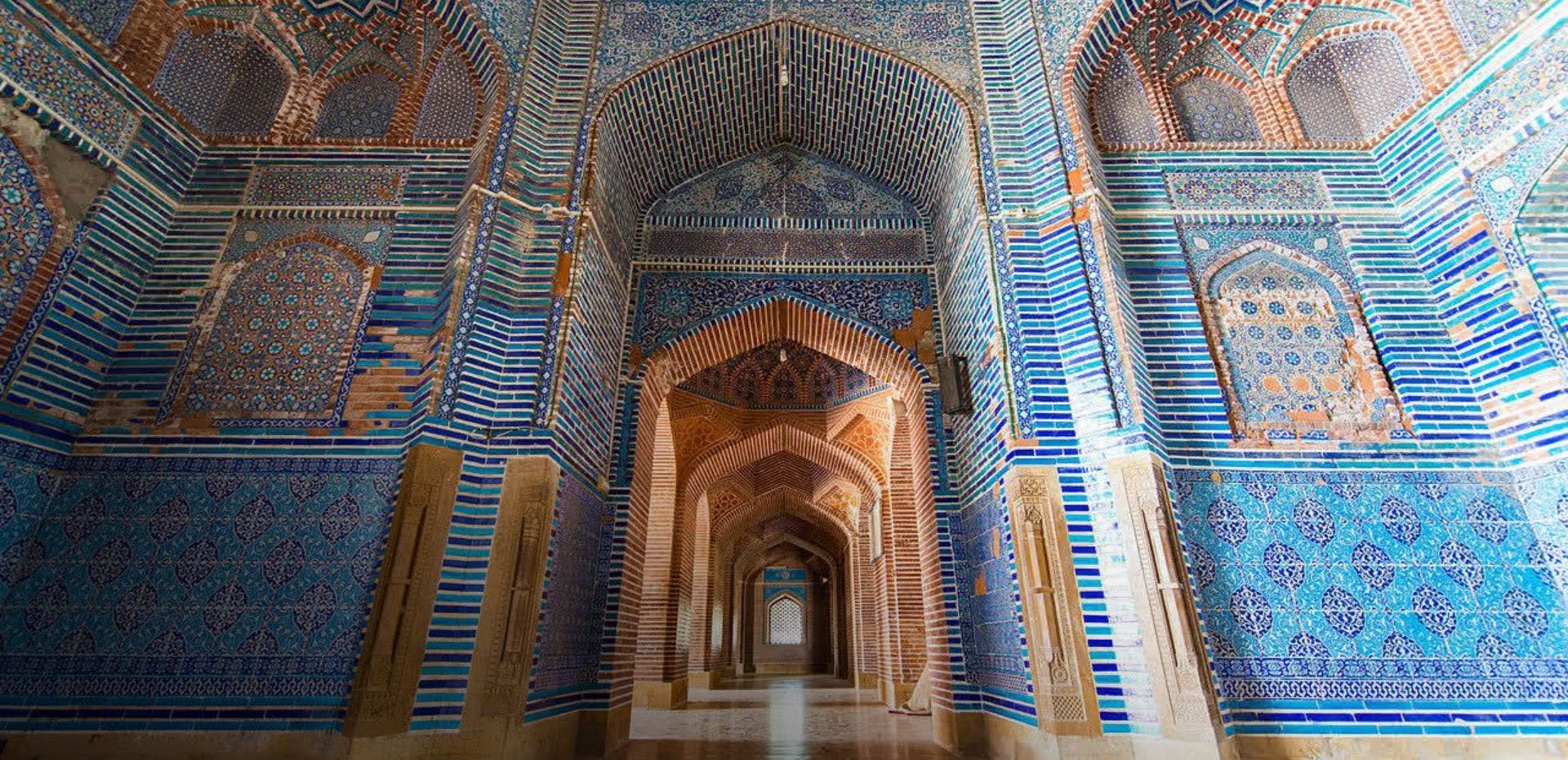Thatta’s Shah Jahan Mosque: A Slice of Samarkand
BOOKMARK
In an unremarkable town in Pakistan’s Sindh province is a stunning blue mosque, a magnificent slice of Samarkand marooned in the Indian subcontinent. Enter the gates of the mosque complex in Thatta and behold a grand masjid unlike any other built by the Mughals.
Called the Shah Jahan Mosque, after the Mughal Emperor who built it in the 17th century CE, the structure is not made of sandstone and marble as are most Mughal monuments. Instead, the Jamia Masjid of Thatta or the Shah Jahan Mosque of Thatta boasts the most elaborate and most beautiful display of tile-work in the subcontinent. An exquisite example of Central Asian architecture, it closely resembles the marvellous mosques, mausoleums and madrasas of Samarkand, the heart of the Mughal homeland.
The town of Thatta is 100 km from Karachi and is no more than a regular urban settlement with a modest population today. It is hard to believe that this was once a provincial capital, the glorious capital city of the Sindh region. Its proximity to the Arabian Sea and to the mouth of the mighty Indus River turned Thatta into an important emporium and a medieval city with immense strategic importance.
Its thriving ports were not only pivotal to trade but also connected Thatta to West Asian maritime networks in Arabia and Persia. Controlling Thatta also meant gaining a measure of control over the mouth of the Indus from rival powers.
A Thriving Provincial Capital
Not surprisingly, Thatta was coveted by all sorts of foreign powers and invaders. It was the seat of the Umayyads in the 8th century CE; it was later ruled by the Arabs and then Mahmud of Ghazni in the early 11th century CE. Between the 11th century CE and the end of the 16th century CE, the Sindh region was captured by the Sumras, Sammas, Arghuns and Tarkhans. The latter were finally subjugated by Mughal Emperor Akbar in 1592 CE.
By now, Thatta was a thriving cultural and provincial capital and it is still littered with monuments dating to between the 10th and 17th centuries CE. Shah Jahan’s Mosque is one of the markers of this medieval era.
The mosque is believed to have been a gift to the people of Thatta from the eponymous monarch. The story goes that in 1626 CE, Prince Khurram, the future Shah Jahan (r. 1628 - 1658), had sought refuge in the Mughal provincial capital of Thatta, after he rebelled against his father, Emperor Jahangir (r. 1605 – 1627). The Prince feared that he had fallen out of his father’s favour despite his successful military campaigns and would not be chosen as the next Emperor. He was also in open conflict with Empress Nur Jahan, his stepmother, who was rooting for her own son, Prince Shahryar (Shah Jahan’s younger brother), to become the next king.
When Prince Khurram visited Thatta, it is said that he was impressed with the hospitality he received from the Sindhi people. So, as a token of gratitude, when he became Emperor, Shah Jahan commissioned a splendid mosque in Thatta.
The Shah Jahan Mosque was built between 1644 and 1647 CE. The main entryway is through a charbagh. The main prayer hall is to the west of the central courtyard, which features iwans in each of its four cardinal directions. The massive, rectangular courtyard is surrounded by aisled galleries, which are lined with 33 arches.
The mosque is famed for its acoustics, and prayers spoken in the mihrab can be heard throughout the building, thanks to an incredible 93 domes of varying sizes that cover the structure. Interestingly, the mosque has no minarets and the walls have exquisite calligraphic work.
Although in need of conservation, Thatta’s mosque is spellbinding and its geometric patterns in brickwork hypnotizing. Its domes, arches, gateways and vaulted interiors are inlaid with mosaics of radiating turquoise and white tiles in floral patterns.
Reclaiming Their Homeland
The mosque, with its distinctive Central Asian style, was built during Emperor Shah Jahan’s ambitious foray into Transoxania, the land between the Amu Darya and Syr Darya, the two rivers defining its boundaries. Today, this region consists of Uzbekistan and some of the other neighbouring ‘stans’. It was from this Central Asian land, from the Fergana Valley in present-day Uzbekistan, that Babur arrived in India in 1526 CE, and established the Mughal dynasty.
Despite the glorious and powerful empire they founded in the subcontinent, the Mughals never stopped pining for their homeland and wanted nothing more than to reclaim it. Shah Jahan, the fifth Mughal Emperor, sent two of his sons, first Prince Murad Bakhsh followed by Prince Muhi-ud-Din Muhammad (the future Aurangzeb), on a massive military expedition to the region in 1646-47 CE.
While they managed to occupy Balkh, in northern Afghanistan, not far from its border with Uzbekistan, and while Aurangzeb pressed further, pushing into Central Asia towards the city of Samarkand, the campaign was a colossal failure.
Thatta’s blue mosque, whose construction coincides exactly with Shah Jahan’s Balkh campaign, is a nostalgic marker of the Mughal Emperor, who had staked so much to wrest back the land of his forefathers.
But unlike his other monuments, like the Taj Mahal in Agra and the Jama Masjid of Delhi, this mosque in Pakistan, although equal in beauty and grandeur, has failed to attract enough attention.
Now, get a chance to engage with leading experts from across the world, enjoy exclusive in-depth content, curated programs on culture, art, heritage and join us on special tours, through our premium service, LHI Circle. Subscribe here.










